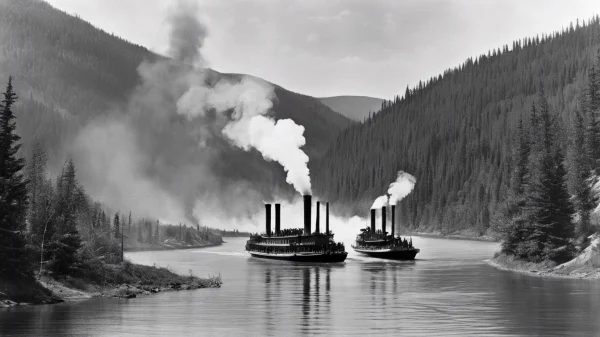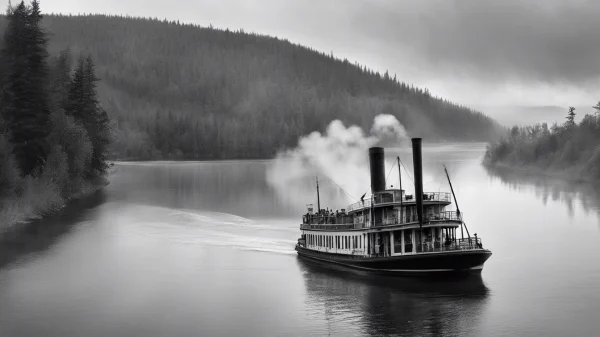Voyage to Upper Canada
Robinson Settler's Journey

April 1825
In the spring of 1825, nine vessels prepared to sail from the Port of Cobe, Ireland. The ships were the Albion, Amity, Brunswick, Elizabeth, Fortitude, John Barry, Regulus, Resolution and Star. Each ship carried families of settlers bound for Upper Canada through an emigration plan created by the government of England and supervised by Peter Robinson.
In Cobe, the early May weather was reaching between 50 and 60 degrees fahrenheit. The days were as often as not, cloudy. Everywhere along the port there was great bustle as preparations were made for the passengers to board their assigned vessels.
In their homes, families spoke in soft hushed voices of what they thought their new life would bring. Would the ocean voyage be made safely? What would they find at their destination? How would they manage without ever again, seeing loved ones left behind back home.

May 1825
As the days moved forward into the month of May 1825, the hustle alongside the secured ships became more intense. Supplies were loaded into the hold. The weather continued in its pattern of cloudy days with rain often drizzling downward. Passengers began appearing along the docks, wandering and looking for the right ship that would soon whisk them away from Ireland and family and friends.
Amid the noise of voices calling, ships at anchor rocking against their moorings and rigging softly rubbing on spars and masts, one can see a man with children, a group of women with young ones, just standing and watching the process of all that was going on around them. Soon it would be time to begin boarding the vessels, not just visiting the docks to see how far along the loading had progressed or to watch supplies being stored on board. Soon, there would be that final day when they too would be loaded on board their sailing ship to begin an ocean voyage to a new world, a new life.

June 1825
On the morning of 11 May 1825, the sailing conditions were right for departure and the ships slowly made their way out of the Port of Cove, heading for the open seas. After many days crossing, the vessels began arriving at their point of destination, the Port of Quebec. The ship John Barry arrived on 15 June 1825, the Brunswick was close behind, making port on the 27 June 1825. Passengers were moved to steamboats that took them onward to the town of La Chine. Here the families were given a few days to a week of rest before once more heading out on their journey inland. From La Chine they took passage on Batteaux that moved them onward to the town of Prescott.

July 1825
From Prescott the settlers travelled in smaller groups, again by boat, to the town of Kingston. Here they were accommodated in tents, while they waited for Peter Robinson to join them. The weather was unusually hot that year. There were some who fell ill from the extreme heat and even a few who died from it. It was not just the newly arriving settlers who fell ill from the excessive heat. Even those who had settled in Upper Canada years earlier, fell ill from the effects of those hot summer days in 1825. The ague with its fevers and shivers made their days long and difficult to endure, for both old settlers and new.
Peter Robinson at last reached the group in Kingston. He had travelled by a different route and had gone up into the Newcastle District to check on arrangements underway in preparation for the coming settlers. He found the travellers encamped at Kingston and tiring from their journey. It was not over yet. The next leg of the voyage was by steamboat from Kingston to Cobourg. In groups of 500, the steamboat captain moved his passengers the 100-mile distance. They were loaded on board at Kingston the one day and disembarked the following day at Cobourg. The steamboat captain could move one group a week along the Lake Ontario waterway.

August 1825
As the humid days of August began, the settlers were transported group by group from Kingston to Cobourg. Here they encamped for a few days before beginning the next part of their travel. While some rested at Cobourg, others were given the task of helping to improve the road north toward Scott’s Plains.
Ahead of the weary travellers lay a barely passable road, running a distance of twelve miles to the shore of Rice Lake. With concern for the terrible condition of the road, Peter Robinson collected funds from the local magistrates and used the money to pay some of the healthier men to work on improving the narrow track through the woods. It took ten days of hard labour but in this manner, it was made passable for both people and wagons.
In addition to the improved roadway, Peter Robinson also prepared for the settlers needing to cross over Rice Lake. To this end he had made two scows. These were transported on wheels from Cobourg up along the newly improved road to the shore of Rice Lake. Each scow was fifty-six feet long and was used to bring the settlers across the lake and as far up the Otonabee River as possible. This part of the journey, from Kingston by steamer, from Cobourg on foot and across Rice Lake by scow, brought the settlers ever closer to their journey’s end, arrival at Scott’s Plains. The first group left Kingston on August 11, 1825. Over the next three weeks the rest of the settlers were moved along this final stage of their voyage to Upper Canada.

September 1825
As the muggy days of August rolled into the cooler weather of September, the settlers had all made their way to Scott’s Plains. Stretching across the flood plain of the Otonabee River, from its riverbank westward to near where Monaghan Road is today, they camped in army style tents. Family groups settled around campfires used both to give a little warmth when needed and over which they prepared all daily meals. The focus was now upon selecting a 100-acre section of land upon which they would settle permanently. As each family chose their land, it was recorded by Peter Robinson’s staff at The Depot as Scott’s Plains was also now becoming known.
Having confirmed a property, the family was issued a Location Ticket, giving permission to begin residing on that land. A log shanty was constructed in which all the family members would live during their first years in Upper Canada. A small dwelling, with dirt floor and sloping log roof to shed rain and snow, the back woods shanty home was a simple homestead.


